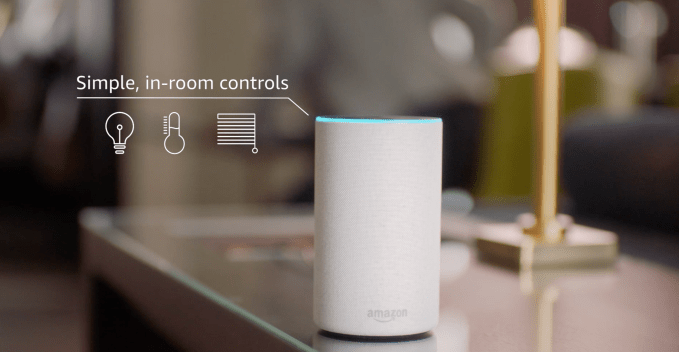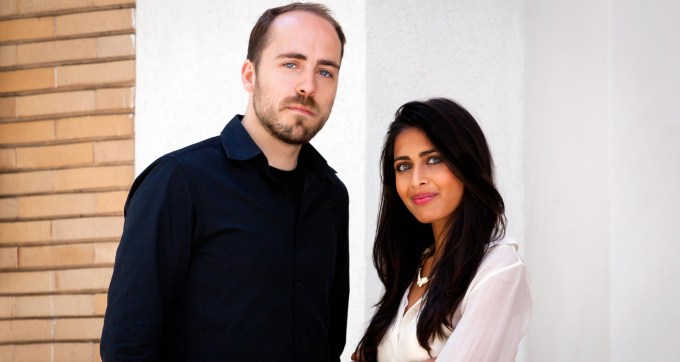Alexa is coming to your hotel room. Amazon this morning is announcing a new program called Alexa for Hospitality, designed to bring its voice assistant technology to everything from chain hotels to vacation rentals. The system can be customized to include key guest information, like checkout time or pool hours; allows guests to request services like housekeeping or room service; and can be configured to control “smart” hotel room functions, like adjusting the thermostat or raising the blinds.
Marriott is Amazon’s launch partner on the new platform, which is notable not only for the potential scale of this rollout, but also because the hotelier had been testing both Siri and Alexa devices ahead of today’s news.
According to Amazon, Marriott International will introduce the new Alexa experience at select properties in Marriott Hotels, Westin Hotels & Resorts, St. Regis Hotels & Resorts, Aloft Hotels, and Autograph Collection Hotels starting this summer.
The system will also be available by invitation to other hospitality providers beginning today.
Alexa for Hospitality works over Echo devices installed in guest rooms which will be customized for the hotel. Currently, supported devices include the Amazon Echo Dot, Echo and Echo Plus.
Via the Echo, guests will be able to ask Alexa for information about the hotel itself – like where the fitness center is located, when the pool is open, and other general information. But they’ll also be able to contact services like in-room dining, the concierge, the front desk, housekeeping, the spa, and so on, just by speaking to Alexa.

Amazon says the system will also work with existing hotel technology, including DigiValet, Intelity, Nuvola, and Volara. This allows guests to say things like “Alexa, order wine” or “Alexa, book a spa appointment,” and then have those requests routed to property management, point of sale, and guest request systems for fulfillment.
Alexa can partially take the place of the in-room telephone, too, as a promo video Amazon shared showed how a guest called her kids at home from her hotel room using just the Echo.

If the hotel desires it, the Alexa system can be customized further to control various “smart home” features like the lights, blinds, the thermostat, and even the TVs.
Specifically, it works with guest room entertainment providers World Cinema and GuestTek for voice control of TV experiences, and offers in-room control of connected devices using Crestron and Inncom by Honeywell, Amazon says.
In addition, the guests will be able to play music and radio over iHeartRadio and TuneIn, which can be set up to play music stations that match the hotel’s brand. (The hotel can control the volume, too, so guests can’t blast their neighbors.)
Guests can access third-party apps for things like workouts, airport wait times, meditation, white noise and more, including custom skills that may tie into a hotel partnership – as with Marriott Hotels’ partnership with TED. In those locations, guest can ask Alexa for a TED Talk on mindfulness, creativity or leadership.

The Alexa for Hospitality system isn’t just the Echo devices in the room, however – it’s a suite of tools for configuring the Echo devices, available via a dashboard where hotels can update their information, enable skills, adjust settings and track usage.
Amazon says the devices are designed to be provisioned in minutes, and can alert an admin if they go offline.
They’ll also allow the hoteliers to measure guest engagement through analytics and reporting, allowing the hotel to adapt its own systems accordingly.

Though not available at launch, the platform will be updated in the future to allow guests to personalize their in-room Echo further by temporarily connecting their own Amazon account for the length of their stay.
This may be the most compelling feature of all.
Hotels are famous for rolling out technology in an effort to cater to their guests’ needs that’s never really used – for example, those in-room Android tablets with hotel info that are too locked-down to enjoy; or those fancy clock radios you unplug so you can instead sleep in the dark with your smartphone by your side.
But with the ability to turn your hotel room Alexa into “your” Alexa, you’d be able to play your own personal music from services like Amazon Music, Spotify and Pandora or continue to listen to your audiobooks from Audible, Amazon says.
Plus, let’s be honest – hotels will be able to capitalize on the fact that Alexa owners have grown so comfortable using Amazon’s virtual assistant, they’ve probably already called out for Alexa by mistake when traveling, forgetting for a moment that she’s not there.
Except now she will be.
Amazon says it’s also working with vacation rental companies like RedAwning, and boutique lifestyle properties within the Two Roads Hospitality portfolio including Thompson Hotels, Joie de Vivre, Destination Hotels and Alila to test out the new platform.
The company declined to share pricing information for the system, nor what (if any) bulk discount the hotels would be getting on their device orders.
“Marriott has a long track record of innovating for our guests, and we’re thrilled to be among the first to offer Alexa for Hospitality,” said Jennifer Hsieh, Vice President Customer Experience Innovation, Marriott International, in a statement about the launch.
“So many of our guests use voice technology in their home, and we want to extend that convenience to their travel experience. Guests of Charlotte Marriott City Center and Marriott Irvine Spectrum will be among the first to experience a curated list of Alexa for Hospitality features. We will be evaluating guest feedback and adoption to inform how we expand the skills, features, and functionality offered through Alexa in our hotels,” she added.
Marriott says that Alexa for Hospitality will be rolled out to ten properties across the U.S. this summer.
This includes the Charlotte Marriott City Center in North Carolina and the Marriott Irvine Spectrum in California where the company often features its latest innovations, as Hsieh noted. It will also be deployed in eight other properties across Westin Hotels & Resorts, St. Regis Hotels & Resorts, Aloft Hotels, and Autograph Collection Hotels brands.













